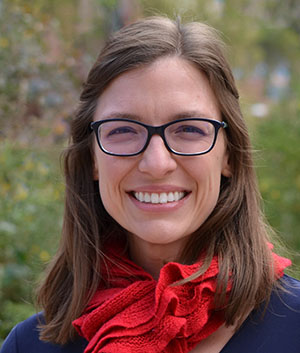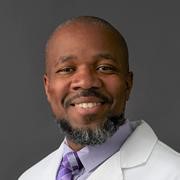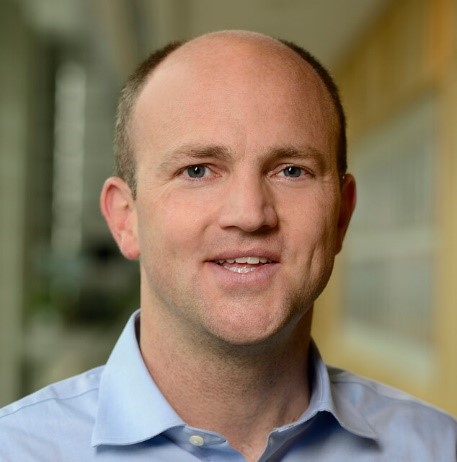
“You’re not going to be able to do biology without understanding programming in the future,” Melissa Wilson, Ph.D., an associate professor of genomics, evolution, and bioinformatics at Arizona State University, said in her 2019 NIGMS Early Career Investigator Lecture. “You don’t have to be an expert programmer. But without understanding programming, I can assert you won’t be able to do biology in the next 20 years.”
A growing number of researchers, like Dr. Wilson, are studying biology using computers and mathematical methods. Some of them started in traditional biology or other life science labs, while others studied computer science or math first. Here, we’re featuring two researchers who took different paths to computational biology.
Using Computational Methods As a Physician-Scientist

Andre Holder, M.D., an assistant professor at Emory University School of Medicine in Atlanta, Georgia, is using machine learning and artificial intelligence to create a way to predict whether patients will develop sepsis, which is the body’s overwhelming or impaired host immune response to an insult—typically an infection, though there can be other causes. Catching and treating sepsis early can help prevent the condition’s more severe outcomes, which include tissue damage, organ failure, and death.
It wasn’t until Dr. Holder finished his medical training and became interested in researching sepsis that he started looking into computational methods. He wanted to search for patterns that predicted sepsis in the extensive patient data that hospitals collect. Traditional methods aren’t practical for such large amounts of data, so he turned to machine learning and artificial intelligence.
Dr. Holder’s computer became his lab. “Over the next decade, computer science—and particularly the marriage between computer science and health care—is going to be increasingly important,” he says. Although all of Dr. Holder’s research is conducted from his office, he’s far from isolated. He spends much of his time meeting with collaborators: data scientists, doctors, and researchers from other fields. For example, he started working with a nutritionist after becoming interested in whether sepsis could be predicted by changes in certain metabolites—substances made or used when the body breaks down food, drugs, or chemicals.
Dr. Holder especially enjoys computational research because it enables him to work with real patient data instead of being a step removed by working with research organisms or cells. “The kind of work that I do never feels like a job; it’s really fun,” he says. “And it’s very rewarding because I’m working on something that I feel I can actually use in my practice later on.”
From Business Software to Stem Cells

As an undergraduate majoring in computer science, Patrick Cahan, Ph.D., never imagined that he’d study biology for a living. In fact, he didn’t take a single biology class while earning his bachelor’s degree. But today, he’s an associate professor of biomedical engineering at Johns Hopkins University School of Medicine in Baltimore, Maryland.
Dr. Cahan’s journey to biomedical research started when he lost interest in his first post-college job as a programmer for a business software company. He began asking friends and mentors about other career opportunities, and a friend who was an M.D./Ph.D. student at the time mentioned that the field of biology needed people who understood computers to work with genomics data.
Dr. Cahan took a break from working full time to consider different career paths and began reading up on genetics and biochemistry. “It’s kind of hard to pick that stuff up just by reading textbooks while you’ve moved back home with your parents and are driving them crazy because they’re trying to figure out what you’re going to do with your life,” he says. “So, I wandered around the halls of a local university’s biology department, knocking on people’s doors and asking if anyone wanted help from a programmer.” Jack Kennell, Ph.D., a professor of biology at Saint Louis University in St. Louis, Missouri, took him up on his offer.
While he volunteered with Dr. Kennell, Dr. Cahan took a genetics class, and those combined experiences solidified his interest in computational biology. He went on to earn a master’s degree in genomics and bioinformatics, and a Ph.D. in computational biology.
In his current research, he uses genomics data and machine learning to find ways to direct the development of stem cells—immature cells with the potential to become many cell types. This work could provide other scientists with particular kinds of cells they need for their studies; in some cases, the research could ultimately lead to treatments for various conditions. Dr. Cahan says that understanding cell development pathways would be extremely difficult without computational methods, but that real-world testing is also essential. His lab has an experimental side where team members apply the methods they’ve developed computationally to living cells.
Dr. Cahan also helps teach an annual weeklong computer-coding boot camp for Ph.D. students in biology at Johns Hopkins. “The boot camp stems from our belief that coding is absolutely necessary,” he says. Even in the unlikely event that students never use coding in their own research, he believes understanding it will be essential to making sense of much other work being done in the field. It seems clear that the amount of research using computational methods is growing with no sign of stopping.
Dr. Holder’s research is supported by NIGMS grant K23GM137182, and Dr. Cahan’s work is supported by NIGMS grant R35GM124725.

This post is a great supplement to Pathways: The Anesthesia Issue.
Pathways discusses machine learning as a possible way to discover a definitive biomarker for pain. This post explains how scientists use computers to study biological processes.
Learn more in our Educator’s Corner.


Thrilling and very compelling!